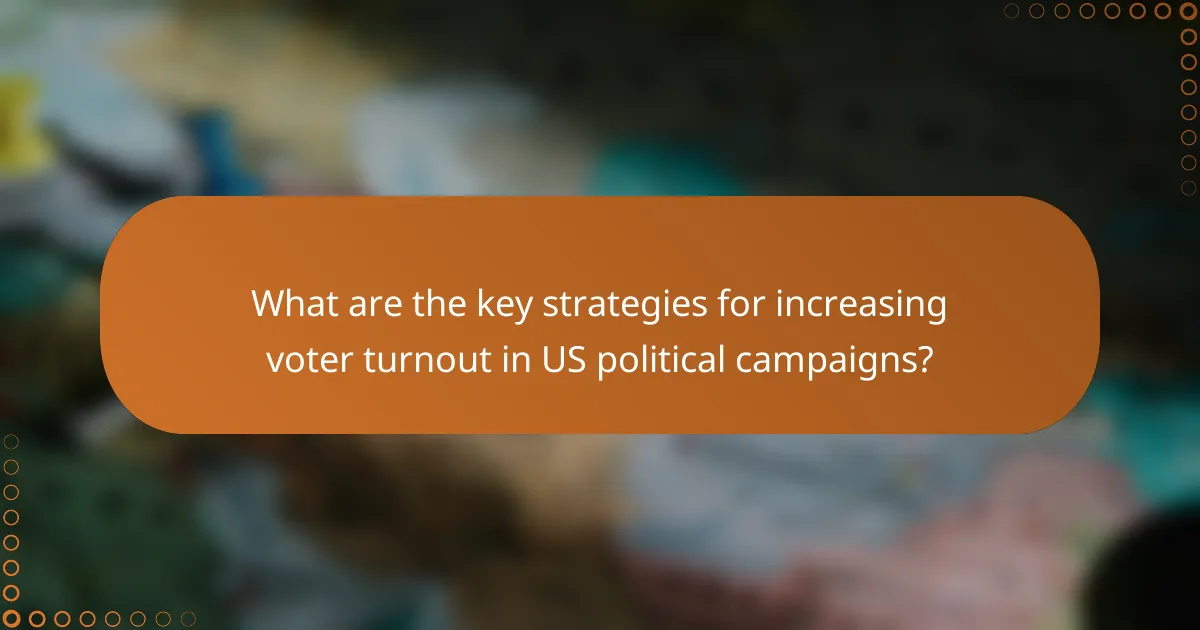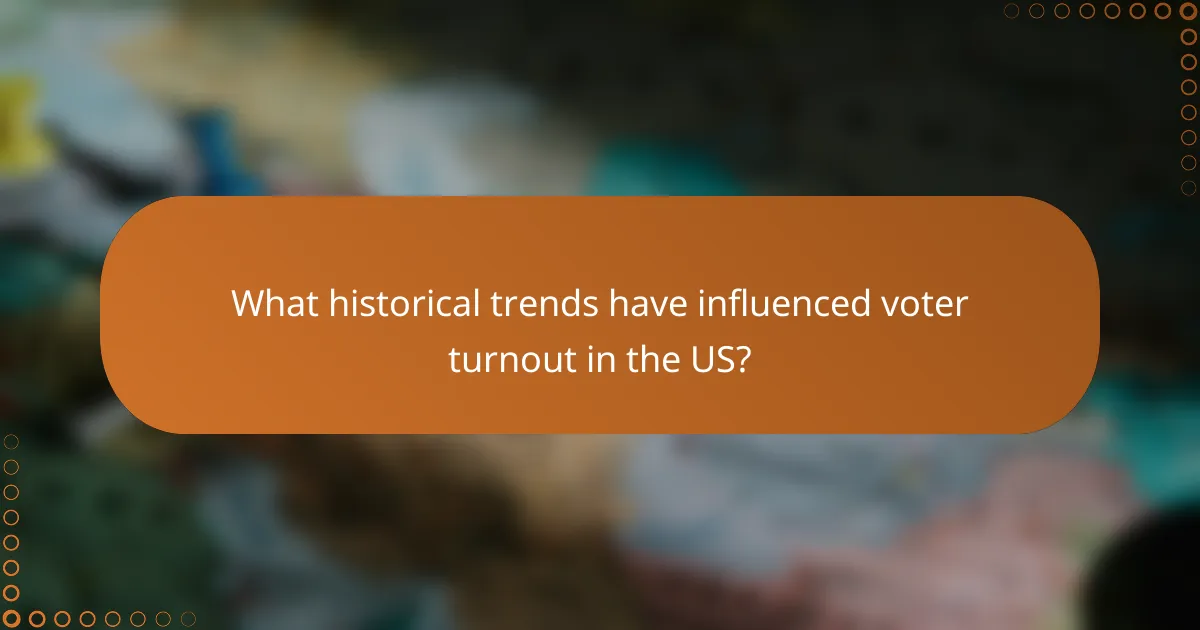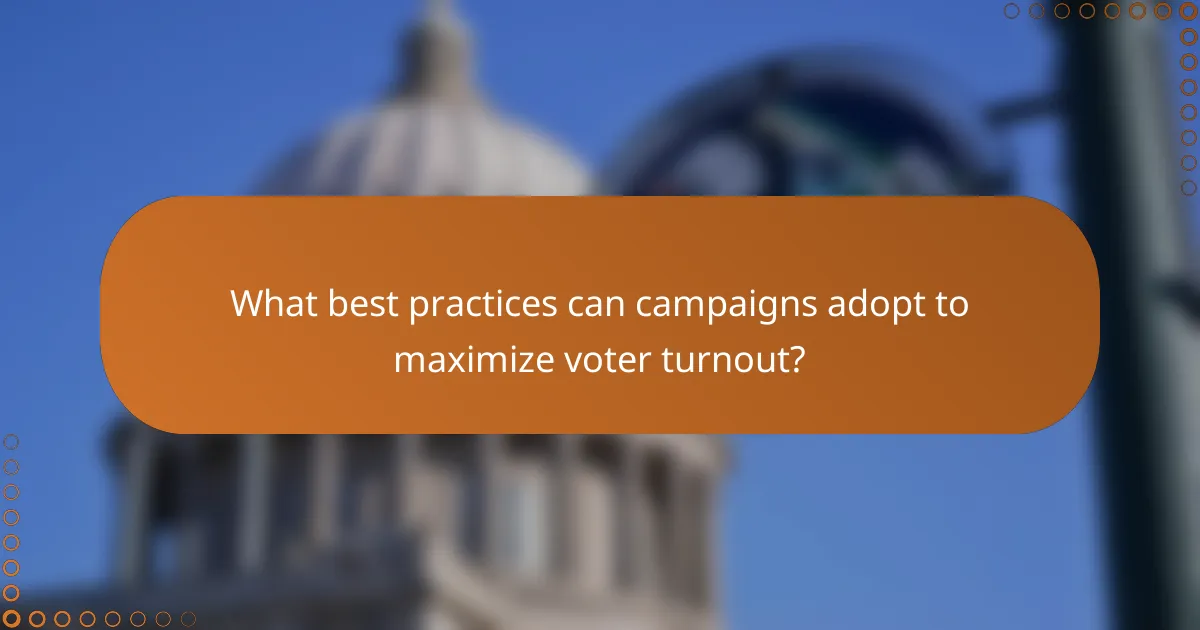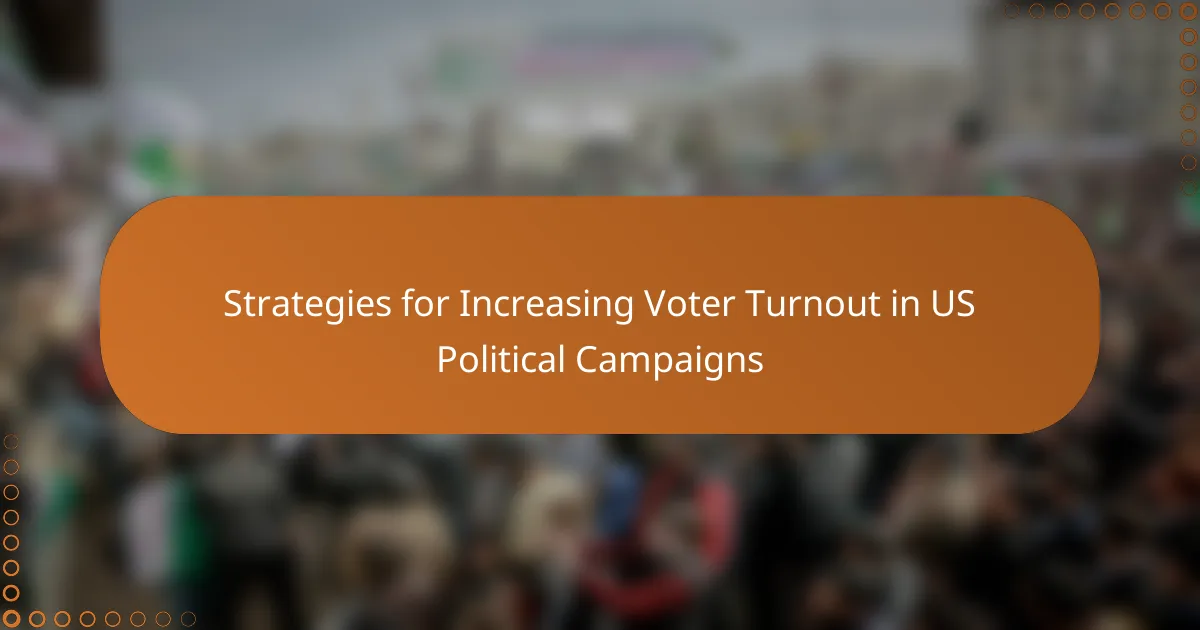Voter turnout in US political campaigns is influenced by various strategies aimed at increasing participation. Key strategies include targeted outreach to specific demographics, simplifying the voting process with measures like same-day registration and early voting, and leveraging social media to engage younger voters. Historical trends such as the Civil Rights Movement and the Voting Rights Act of 1965 have shaped voter registration and participation rates. Effective campaign tactics, including door-to-door canvassing, clear communication about voting procedures, and addressing barriers to voting, are essential for maximizing turnout and fostering community engagement.

What are the key strategies for increasing voter turnout in US political campaigns?
Key strategies for increasing voter turnout in US political campaigns include targeted outreach, simplifying the voting process, and leveraging social media. Targeted outreach involves identifying and engaging specific demographics that are less likely to vote. Research shows that personalized communication can increase participation by up to 20%. Simplifying the voting process, such as offering same-day registration and early voting, has proven effective. States that implemented these measures saw turnout increases of 5-10%. Leveraging social media helps campaigns reach younger voters who are more active online. Studies indicate that social media campaigns can boost turnout among young voters by 10-15%.
How do different demographics impact voter turnout strategies?
Different demographics significantly impact voter turnout strategies. Age, race, income, and education level influence participation rates. Younger voters tend to have lower turnout compared to older voters. In the 2020 election, individuals aged 18-29 voted at a rate of 50%. This is lower than the 71% turnout for those aged 65 and older. Racial minorities often face unique barriers to voting, leading to targeted outreach efforts. For example, Black and Hispanic voters historically encounter challenges such as voter ID laws. Income levels also affect turnout; higher-income individuals generally vote at higher rates. In 2018, 58% of individuals with a household income over $100,000 voted, compared to 36% of those earning under $30,000. Education plays a critical role as well; individuals with college degrees are more likely to vote. In 2020, 77% of college graduates participated in the election. Campaigns adapt their strategies based on these demographic insights to maximize voter engagement.
What specific strategies resonate with young voters?
Engaging young voters requires targeted strategies that resonate with their values. Social media campaigns effectively reach this demographic, as 90% of young adults use social platforms. Authentic messaging that reflects their concerns, such as climate change and social justice, is crucial. Peer-to-peer outreach increases engagement, as young voters trust recommendations from friends. Events and rallies that foster community and connection can drive turnout, with studies showing participation increases by 20% when friends attend together. Additionally, simplifying the voting process through apps and clear information encourages participation among first-time voters.
How can campaigns effectively engage minority communities?
Campaigns can effectively engage minority communities by prioritizing authentic representation and culturally relevant messaging. Building trust is essential; campaigns should involve community leaders in planning and outreach. Utilizing local events and platforms can enhance visibility and accessibility. Tailoring communication to reflect the community’s values and concerns fosters connection. Data indicates that when campaigns invest in grassroots organizing, they see increased voter turnout. For instance, the 2020 elections showed that targeted outreach in minority neighborhoods led to a significant rise in participation rates.
What role does technology play in enhancing voter turnout?
Technology significantly enhances voter turnout through various means. It streamlines the registration process, making it easier for individuals to register to vote. Online registration systems have increased accessibility, particularly among younger voters. Mobile applications provide reminders and information about voting dates and locations. Social media platforms facilitate engagement and awareness campaigns, reaching a broader audience. Data analytics help campaigns target specific demographics effectively. According to the U.S. Census Bureau, states that implemented online registration saw an increase in participation rates by up to 10%. These technological advancements contribute to a more informed and engaged electorate, ultimately boosting voter turnout.
How can social media campaigns influence voter participation?
Social media campaigns can significantly influence voter participation by increasing awareness and engagement. These campaigns utilize targeted advertisements to reach specific demographics. They provide information about voting procedures and deadlines. Social media platforms facilitate discussions and mobilize communities. Research shows that social media can increase voter turnout by 3-5%. For example, a study by the Pew Research Center found that 50% of social media users learned about the election through these platforms. Additionally, social media can create a sense of urgency and excitement around voting.
What are the benefits of using mobile apps for voter engagement?
Mobile apps enhance voter engagement by providing accessible information and resources. They allow users to easily check registration status and polling locations. Apps can send reminders about upcoming elections and deadlines. Users can receive personalized content based on their interests and demographics. Interactive features enable users to participate in surveys and discussions. Data shows that mobile app users are more likely to vote. A study by the Pew Research Center found that 45% of smartphone users engage with civic-related content. This indicates that mobile apps effectively mobilize voters and increase turnout.

What historical trends have influenced voter turnout in the US?
Voter turnout in the US has been influenced by several historical trends. Major events such as the Civil Rights Movement significantly increased voter registration among African Americans. The Voting Rights Act of 1965 eliminated many barriers to voting, leading to higher participation rates. Economic factors, like the Great Depression, also impacted turnout, as citizens sought to influence policy through voting. Additionally, changes in voting technology, such as the introduction of electronic voting machines, have affected accessibility. Political mobilization efforts, especially during presidential elections, have historically driven turnout. Overall, these trends reflect the dynamic relationship between societal changes and voter engagement.
How have past elections shaped current turnout strategies?
Past elections have significantly influenced current voter turnout strategies. Historical data reveals patterns in voter behavior that shape campaign approaches. For example, the 2008 election highlighted the effectiveness of grassroots mobilization. Campaigns now prioritize direct voter engagement through door-to-door canvassing and phone banking. The use of data analytics has also evolved, allowing campaigns to target specific demographics more effectively. Additionally, past elections showed the importance of early voting and mail-in ballots, prompting campaigns to promote these options. The 2020 election further emphasized digital outreach, with social media playing a crucial role in mobilization efforts. These lessons have led to more comprehensive and adaptive turnout strategies in contemporary campaigns.
What lessons can be learned from the 2020 presidential election?
The 2020 presidential election highlighted the importance of voter engagement strategies. High voter turnout was achieved through targeted outreach and mobilization efforts. The election saw an increase in mail-in voting options, which expanded access. Data showed that states with early voting saw higher participation rates. Social media played a crucial role in informing and mobilizing voters. Campaigns that focused on local issues resonated more with constituents. Mobilization efforts among young voters significantly impacted turnout. The election underscored the need for continuous voter education and outreach.
How did voter turnout evolve during significant historical events?
Voter turnout has significantly evolved during major historical events. For instance, during the Civil Rights Movement in the 1960s, voter turnout among African Americans surged due to increased advocacy and legislative changes. The Voting Rights Act of 1965 eliminated barriers to voting, resulting in a dramatic increase in participation. In the 2008 presidential election, turnout reached its highest level in decades, driven by the historic candidacy of Barack Obama and a strong mobilization effort. Conversely, events like the Great Depression in the 1930s saw lower voter turnout as economic hardships led to disillusionment with the political process. Additionally, the aftermath of the September 11 attacks in 2001 saw a temporary spike in civic engagement, yet subsequent elections reflected a decline in turnout due to voter apathy. These trends illustrate that significant historical moments can either mobilize or demobilize voters, impacting overall participation rates.
What psychological factors affect voter turnout?
Psychological factors significantly affect voter turnout. Key factors include motivation, social influence, and perceived efficacy. Motivation can stem from personal beliefs and values related to political issues. Social influence involves the impact of peers and community norms on an individual’s decision to vote. Perceived efficacy refers to the belief that one’s vote can make a difference. Research indicates that individuals who feel their participation is meaningful are more likely to vote. For example, a study by the Pew Research Center found that 80% of those who believe their vote matters reported higher turnout rates.
How does motivation impact an individual’s likelihood to vote?
Motivation significantly influences an individual’s likelihood to vote. Higher motivation leads to increased engagement in the electoral process. Motivated individuals are more likely to research candidates and issues. They often feel a sense of civic duty and responsibility. Studies show that motivated voters participate at higher rates. For example, a study by the Pew Research Center found that motivated voters are 20% more likely to cast their ballots. Additionally, personal factors like beliefs and values enhance motivation levels. This connection between motivation and voting behavior is crucial for understanding turnout strategies.
What role does civic education play in shaping voter behavior?
Civic education plays a crucial role in shaping voter behavior. It informs individuals about their rights and responsibilities as citizens. This knowledge empowers them to participate in the electoral process. Studies show that civic education increases political engagement and awareness. For instance, a report by the Center for Information and Research on Civic Learning and Engagement found that students receiving civic education are more likely to vote. Furthermore, civic education fosters critical thinking skills. These skills enable voters to evaluate candidates and policies effectively. Ultimately, informed voters contribute to higher voter turnout.

What best practices can campaigns adopt to maximize voter turnout?
Campaigns can maximize voter turnout by implementing targeted outreach strategies. These strategies include door-to-door canvassing, which has been shown to increase turnout by 7% to 12%. Additionally, using social media effectively can engage younger voters, who are more likely to respond to digital campaigns.
Providing clear information about voting procedures is crucial. Research indicates that voters who receive information about polling locations and hours are more likely to participate. Mobilizing volunteers to remind voters on election day can also significantly boost turnout.
Furthermore, campaigns should focus on building relationships within communities. Engaging local leaders can enhance trust and motivate residents to vote. Data from the 2020 election shows that personalized communication, such as text messages or phone calls, can increase turnout rates by up to 5%.
Finally, addressing barriers to voting, such as transportation and accessibility, can ensure that more people can cast their ballots. Strategies like offering rides to polling places have proven effective in previous elections.
How can grassroots efforts enhance voter engagement?
Grassroots efforts can enhance voter engagement by fostering community involvement and building trust. These initiatives often involve local volunteers who connect with residents on a personal level. By organizing events like town halls, grassroots campaigns create platforms for dialogue. They also provide information about voting processes and deadlines, ensuring voters are informed. Additionally, grassroots efforts often use social media to reach younger demographics effectively. Statistics show that personal outreach can increase voter turnout by up to 20%. Engaging communities through these means leads to a more informed and motivated electorate.
What are effective methods for organizing community events?
Effective methods for organizing community events include thorough planning, clear communication, and active engagement. Start by defining the event’s purpose and target audience. Create a detailed timeline and checklist to manage tasks efficiently. Use multiple communication channels to promote the event, such as social media, local newspapers, and community boards. Involve local organizations and volunteers to enhance outreach and participation. Gather feedback from attendees to improve future events. Research shows that well-organized events can increase community involvement by up to 40%.
How can door-to-door canvassing improve voter turnout?
Door-to-door canvassing can significantly improve voter turnout by providing personalized engagement. This method allows canvassers to directly communicate with potential voters. Personal interactions can address questions and concerns about the voting process. Research shows that face-to-face engagement increases the likelihood of voting. For instance, a study by the University of California found that door-to-door canvassing increased turnout by 7% in targeted demographics. Canvassing also helps to identify and mobilize voters who may be less likely to participate. By creating a sense of community and urgency, canvassers can motivate individuals to vote. Ultimately, this strategy fosters a more informed electorate and enhances civic participation.
What are the most common challenges campaigns face in increasing voter turnout?
Campaigns face several common challenges in increasing voter turnout. One major challenge is voter apathy, where individuals feel disillusioned or believe their vote does not matter. This is often exacerbated by negative political messaging. Another challenge is logistical barriers, such as lack of access to polling places or inadequate transportation options. Research indicates that 15% of voters cite these logistical issues as a reason for not voting. Additionally, misinformation can mislead voters about when and how to vote. Campaigns also struggle with mobilizing young voters, who historically have lower turnout rates. According to the U.S. Census Bureau, only 50% of eligible voters aged 18-29 participated in the 2020 election. Lastly, the complexity of the voting process, including registration requirements and ballot design, can deter participation. These challenges collectively hinder efforts to boost voter turnout in political campaigns.
How can campaigns overcome misinformation and voter apathy?
Campaigns can overcome misinformation and voter apathy by implementing targeted educational initiatives. These initiatives should focus on fact-checking and providing accurate information to counter false narratives. Research indicates that voters are more likely to engage when they receive clear, factual information. Additionally, campaigns can leverage social media platforms to disseminate correct information rapidly. Engaging influencers and community leaders can also help amplify positive messages. According to a study by the Pew Research Center, 64% of Americans believe misinformation has a significant impact on political discourse. By addressing misinformation directly, campaigns can foster trust and encourage voter participation.
What strategies can mitigate logistical barriers to voting?
Strategies to mitigate logistical barriers to voting include enhancing accessibility, providing clear information, and improving transportation options. Accessibility can be improved by ensuring polling places are compliant with the Americans with Disabilities Act. Clear information on voting procedures and locations should be disseminated through multiple channels, including social media and community outreach. Transportation assistance can be provided through partnerships with local organizations or ride-sharing services to help voters reach polling sites. Studies show that states with extended voting hours and early voting options see higher voter turnout. Implementing these strategies can lead to a more inclusive electoral process.
What actionable tips can campaigns implement to boost voter turnout?
Campaigns can boost voter turnout by implementing targeted outreach strategies. Personalized communication increases engagement. Sending tailored messages through emails or texts can motivate specific voter demographics. Organizing community events fosters a sense of belonging. These events can connect voters with candidates and issues. Utilizing social media platforms effectively reaches younger voters. Online campaigns can mobilize supporters quickly. Providing clear information about voting procedures is essential. Voters need to know when and how to vote. Offering transportation assistance can remove barriers for those without access. Research indicates that these strategies can significantly increase turnout rates.
The main entity of the article is ‘strategies for increasing voter turnout in US political campaigns.’ The article provides a comprehensive overview of effective methods to enhance voter participation, including targeted outreach, simplifying the voting process, and leveraging technology and social media. It discusses how demographic factors influence turnout strategies, particularly among young and minority voters. Additionally, the article examines historical trends, psychological factors, and logistical challenges that impact voter engagement, offering actionable tips for campaigns to maximize turnout.
